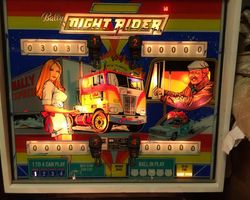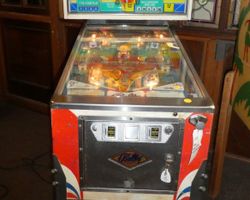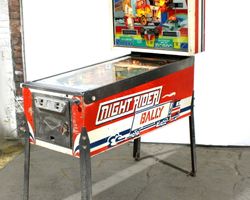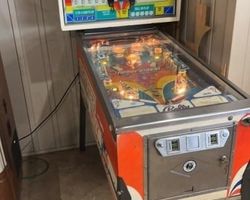Night Rider

Average Prices: USD $300 to $900
Produced: November, 1976
Production Run: 4,155 units
Machine Type: Electro-mechanical
Players: 4
Design by: Greg Kmiec
Art by: Paul Faris
Bally Manufacturing Corporation introduced "Night Rider" in November 1976, an electro-mechanical (EM) pinball machine that captured the spirit of the era's burgeoning trucking and CB radio culture. Designed by Greg Kmiec with artwork by Paul Faris, this machine emerged when the imagery of long-haul truckers and their open-road adventures resonated with a wide audience. "Night Rider" was produced in an impressive run of 4,155 units, establishing it as a significant release for Bally during a transitional period in pinball history, as solid-state (SS) technology was beginning to emerge. Kmiec's design philosophy for "Night Rider" centered on creating an engaging, fast-paced game that appealed to both dedicated players and casual enthusiasts, drawing inspiration from the popularity of films and media that romanticized the life on the highway. Paul Faris's artistic contributions brought the theme to life, particularly noted for the captivating backglass art that depicts the machine’s central figures within the trucking motif. The game's robust production numbers and its timely theme solidified its place as a memorable title from the mid-1970s. It was also released in an SS version shortly after, though the EM iteration often garners particular appreciation for its distinctive mechanical sounds and feel.
Signature Features and Design
"Night Rider" is defined by several standout elements that contribute to its gameplay and overall appeal. Central to its design are the two spinning targets, strategically placed on the upper playfield. These spinners are consistently highlighted by players as a primary source of satisfaction, offering a distinctive "rip" sound and feel as the ball passes through them, accumulating points rapidly. The design ensures these shots are both rewarding and challenging, encouraging players to aim for them repeatedly.
Another prominent feature is the two banks of five drop targets each. These ten targets not only serve as a significant scoring opportunity but also introduce a tactical element, as players aim to clear entire banks for bonus points. Their reset mechanism and satisfying thud when hit provide tangible feedback during gameplay.
Perhaps the most celebrated design aspect is the "King of the Road" feature, activated when a player's score surpasses 99,990 points. Upon reaching this milestone, the backglass briefly illuminates the words "King Of The Road" accompanied by a distinct buzzer sound, and a silkscreened "100,000" lights up on the backglass as the mechanical score reels seamlessly roll over to zero for continued scoring. This visual and auditory reward elevates the experience, transforming a high score into a triumphant moment. The machine also incorporates a kick-out hole in the center of the playfield, which awards variable points and, notably, offers the chance for a double bonus, adding an element of surprise and replayability to each game. The cohesive artwork by Paul Faris, especially the detailed backglass featuring a waitress character and truck stop imagery, enhances the theme, immersing players in the trucking world.
Playfield and Mechanics
The "Night Rider" playfield layout is a testament to Greg Kmiec's design principles, emphasizing a combination of open space for flowing shots and specific targets for skill-based play. The primary playfield elements include two flippers at the bottom, which provide control for targeting the various features. Above the flippers, two slingshots on either side angle shots towards the upper playfield. Three pop bumpers are positioned in the upper-mid section, contributing to chaotic ball movement and score accumulation.
The two banks of five drop targets are prominent, one on each side of the playfield, requiring precise shots to clear. These are complemented by three standup targets strategically placed, including a central one that, while offering points, can be a high-risk shot due to its direct path to the drain. The two spinning targets are positioned in the upper portion, offering high-scoring opportunities for players who can consistently hit them. A central kick-out hole provides varied awards, adding an element of chance and excitement.
The playfield's design fosters a fast-paced game, characteristic of many successful EM titles. The open areas allow for rapid ball movement, while the arrangement of targets encourages players to find their rhythm and execute successive shots. The visual aesthetic is a direct reflection of its 1970s trucking theme. Paul Faris's artwork adorns the playfield with trucks, road signs, and other elements that evoke the open highway. The lighting is functional yet effective, highlighting scoring areas and providing visual cues during gameplay, culminating in the "King of the Road" backglass illumination for high scores, which serves as a powerful visual and auditory marker of player achievement. The overall design philosophy balances straightforward objectives with opportunities for skillful play, contributing to an engaging experience.
Gameplay Dynamics
Gameplay on "Night Rider" is driven by its intuitive mechanics and satisfying feedback, characteristic of a well-executed electro-mechanical machine. The primary objective is to score points by hitting the various targets and features on the playfield. Each successful shot, whether hitting a standup target, clearing a drop target, or activating a pop bumper, contributes to the player's score, audibly registered by the mechanical score reels and the chime unit.
The two spinning targets are central to high-scoring strategies. Players quickly learn the satisfying "rip" sound and feel that accompanies a well-struck spinner shot, which can rapidly accumulate points. Clearing the two banks of five drop targets provides significant score bonuses and resets them for another opportunity. The central kick-out hole introduces an element of chance, with its variable awards, including the coveted double bonus, which can significantly boost end-of-ball scores.
A core objective for players is to reach the 100,000-point mark, which triggers the memorable "King of the Road" sequence. This milestone is not just a numerical achievement but a celebrated moment in the game, marked by the backglass lighting up and the distinctive buzzer, followed by the score reels resetting to allow continued scoring up to 199,990 points. This replay system ensures that high-scoring games remain engaging without immediately ending. Players often develop strategies around maximizing spinner shots and completing drop target banks, while also managing the risk associated with certain shots, such as the central stand-up target, which can sometimes lead to quick drains. The end-of-ball bonus system encourages players to build up their bonus multiplier throughout each ball. The game's sound package, powered by the chime unit, provides satisfying auditory feedback for every hit and score event, enhancing the immersive experience of this pinball machine.
Reception and Legacy
"Night Rider" has largely enjoyed a positive reception within the pinball community, particularly among enthusiasts of electro-mechanical machines. Its strengths are frequently highlighted, with the spinning targets receiving near-universal praise for their satisfying "rip" sensation and their contribution to fast-paced scoring. The two banks of drop targets are also well-regarded, offering engaging objectives and a rewarding tactile experience. The game's theme, deeply rooted in the 1970s trucking and CB radio culture, is a significant draw for many, evoking a sense of nostalgia. The artwork, especially Paul Faris's backglass featuring the waitress, is often cited as appealing and effective in establishing the game's identity.
Gameplay flow and speed are consistently lauded, making "Night Rider" a game that feels dynamic and engaging for both short and extended sessions. Its rules are generally considered accessible, making it an approachable title for new players while still offering enough depth to keep experienced players invested. The "King of the Road" feature, with its distinctive light and buzzer when a player crosses 100,000 points, is a memorable and satisfying reward that many players fondly recall. The variable awards from the kick-out hole, particularly the chance for a double bonus, add an element of unpredictability and excitement. The sound package, centered around the chime unit, contributes positively to the overall experience. Many players express a preference for the EM version over its solid-state counterpart, valuing the mechanical feel and the specific sounds of the score reels. Furthermore, "Night Rider" is often noted for its family-friendly appeal, making it a suitable game for players of all ages.
Despite its many strengths, "Night Rider" does have some areas that receive less favorable feedback. The cabinet artwork, while consistent with the theme, is sometimes described as being plainer or more dated compared to the playfield and backglass art. Some players note that the outlanes can be "voracious," leading to frustrating drains and challenging ball control. The variable award for the double bonus, while exciting, can feel overly reliant on chance for some players. A few observations point to the game's pace occasionally slowing down if the ball meanders, though this is not a pervasive complaint. The center stand-up target is sometimes referred to as a "deathshot," advising players against aiming directly for it due to the high risk of a quick drain. One perspective suggests that while the layout is compelling, the balance and reliability of the rules may not perfectly align with the demanding nature of the playfield.
"Night Rider" holds a respected position in pinball history as a popular and enduring electro-mechanical machine from the 1970s. Its combination of a strong theme, engaging features, and accessible yet fast-paced gameplay ensures its continued appreciation within the community. It stands as an example of Bally's ability to produce machines that resonate with players and define an era of pinball design.
Sponsored Links
 Ebay Listings
Ebay Listings
 Auction Results
Auction Results
| Cost | Location | Date |
|---|---|---|
| USD $410 |  Alabama, United States Alabama, United States |
24 April, 2025 |
| USD $1,000 |  Florida, United States Florida, United States |
28 January, 2025 |
| USD $1,000 |  Florida, United States Florida, United States |
27 November, 2024 |
| EUR €1,500 |  Nordrhein-Westfalen, Germany Nordrhein-Westfalen, Germany |
11 November, 2024 |
| USD $600 |  Florida, United States Florida, United States |
15 October, 2024 |
| GBP £900 |  Herne Bay, United Kingdom Herne Bay, United Kingdom |
28 June, 2024 |
| USD $725 |  Washington, United States Washington, United States |
20 June, 2024 |
| USD $910 |  Kansas, United States Kansas, United States |
17 March, 2023 |
| GBP £999 |  United Kingdom United Kingdom |
24 November, 2022 |
| USD $1,649 |  New York, United States New York, United States |
13 September, 2022 |


Private Policy · Search Website · Contact Us
As an eBay Partner, we may earn a commission from qualifying purchases made through links on this site, at no additional cost to you.
All trademarks and copyrighted materials remain property of their respective owners. All other content copyright 2007 - 2026 Pinpedia.







